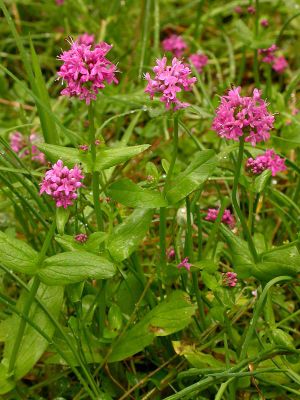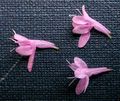Difference between revisions of "Plectritis congesta"
| (11 intermediate revisions by 4 users not shown) | |||
| Line 1: | Line 1: | ||
| − | ''' | + | *Scientific Name: ''Plectritis'' ''congesta'' |
| − | + | * Family: Valerianaceae | |
| − | '' | + | * Common Names: rosy plectritis, sea-blush |
| − | + | * Codon: PLECON | |
| − | + | ---- | |
| − | + | [[File:PLECCON1.jpg|thumb|Photo by Ben Legler, 2004, also featured on Main Page]] | |
| − | + | ||
| − | + | ||
| − | + | ||
| − | *Family: | + | |
| − | * | + | |
| − | + | ||
| − | + | ||
| − | + | ||
| − | + | ||
| − | + | ||
| − | + | ||
| − | == | + | ===Taxonomy=== |
| − | + | {{Taxobox | |
| + | | name = | ||
| + | | regnum = [[Plant]]ae | ||
| + | | subregnum = Viridiplantae | ||
| + | | phylum = Tracheophyta | ||
| + | | subphylum= Spermatophytina | ||
| + | | classis = Magnoliopsida | ||
| + | | subclassis = Asteranae | ||
| + | | ordo = Dipsacales | ||
| + | | familia = Valerianaceae | ||
| + | | genus = ''Plectritis'' (Lindl.) DC. | ||
| + | | species = '''''Plectritis congesta''''' (Lindl.) DC | ||
| + | }} | ||
| + | <ref>Integrated Taxonomic Information System. Retrieved from https://www.itis.gov/servlet/SingleRpt/SingleRpt?search_topic=TSN&search_value=35379#null</ref> | ||
| − | == | + | ===Description=== |
| − | + | Native annual perennial herb, 1-6 dm. tall. | |
| − | + | Leaves are opposite, oblong, egg-shaped towards the bottom of the plant. | |
| − | + | ||
| − | + | ||
| − | + | ||
| − | + | ||
| − | + | ||
| − | + | ||
| − | ==Uses== | + | Flowers are pink to white, have 5 petals, formed into a bilabiate corolla with a well-developed spur, and form terminal clusters. |
| − | ==Propagation== | + | |
| − | Seeds were sown into | + | Fruit is a dry carpel, the convex side keeled, 2-4 mm.<ref>Bowcutt, F., & Hamman, Sarah. (2016). ''Vascular plants'' |
| + | of the South Sound prairies'' (First ed.). Olympia, Washington: The Evergreen'' | ||
| + | State College Press.</ref><ref name=":0">WTU Herbarium, Burke Museum, | ||
| + | & University of Washington. Retrieved from <nowiki>https://biology.burke.washington.edu/herbarium/imagecollection/taxon.php?Taxon=Plectritis%20congesta</nowiki></ref> | ||
| + | |||
| + | Name comes from Greek ''plektos'', plaited, presumably referring to the complex inflorescence.<ref name=":1">Hitchcock, C. L., Cronquist, A., Giblin, D., & Legler, | ||
| + | B. et al. (2018). ''Flora of the Pacific Northwest: an illustrated manual''. | ||
| + | Seattle: University of Washington Press.</ref> | ||
| + | |||
| + | ===Bloom Period=== | ||
| + | April - June<ref name=":0" /> | ||
| + | |||
| + | ===Distribution=== | ||
| + | Vancouver Island, BC, south to California, mostly west of the Cascades.<ref name=":1" /> | ||
| + | |||
| + | ===Habitat=== | ||
| + | This plant prefers open to partly shaded meadows and slopes that are moist in the spring, but also grows along coastal bluffs, rocky balds, and roadsides in spring-moist areas or seeps.<ref name=":2">Young-Mathews, A. 2012. Plant fact sheet for shortspur seablush (Plectritis congesta). USDA-Natural Resources Conservation Service, Plant Materials Center, Corvallis, OR.</ref> | ||
| + | |||
| + | ===Uses=== | ||
| + | Flowers provide a spring nectar source for bumble bees and other native bees, as well as butterflies including the endangered Fender’s blue (''Plebejus icarioides fender''i) and the rare Taylor’s checkerspot (''Euphydryas editha taylori'').<ref name=":2" /> | ||
| + | |||
| + | ===Propagation=== | ||
| + | Seeds were sown into containers filled with Sunshine # 1 (a soil-less peat-based media) amended with micro-nutrients (Micromax) and a slow-release fertilizer (Osmocote 14-14-14.) | ||
Flats were placed in greenhouse set at moderate temperatures (70 degree days/50 degree nights.) | Flats were placed in greenhouse set at moderate temperatures (70 degree days/50 degree nights.) | ||
| − | Seeds germinated within one to two weeks. 60% germination | + | Seeds germinated within one to two weeks. 60% germination occurred. |
Fruit and Seed Collection and Extraction | Fruit and Seed Collection and Extraction | ||
| − | Collection: Plant develops two different fruits/seeds--fruit polymorphisms. Both types of seed can be easily shaken into an envelope or bag when ripe. All the plants do not ripen at the same time. Special care must be taken when cleaning seed as their shape and size differs. | + | Collection: Plant develops two different fruits/seeds--fruit polymorphisms. Both types of seed can be easily shaken into an envelope or bag when ripe. All the plants do not ripen at the same time. Special care must be taken when cleaning seed as their shape and size differs.<ref>Bartow, Amy. 2004. Propagation protocol for production of Container (plug) ''Plectritis congesta'' |
| + | (Lindley) A. DC. plants USDA NRCS - Corvallis Plant Materials Center | ||
| + | Corvallis, Oregon. In: Native Plant Network. URL: | ||
| + | <nowiki>http://NativePlantNetwork.org</nowiki> (accessed 2020/06/02). US Department of | ||
| + | Agriculture, Forest Service, National Center for Reforestation, | ||
| + | Nurseries, and Genetic Resources.</ref> | ||
| − | ==Photo Gallery== | + | ===Photo Gallery=== |
| − | < | + | <gallery> |
| − | File: | + | File:PLECCON2.jpg|Photo: Ben Legler, 2004 |
| − | File: | + | File:PLECCON3.jpg|Photo: Ben Legler, 2004 |
| − | File: | + | File:PLECON4.jpg|Young growth, photo courtesy of CNLM |
</gallery> | </gallery> | ||
| − | ==References== | + | ===References=== |
| − | <references/> | + | <references /> |
Latest revision as of 22:27, 20 March 2021
- Scientific Name: Plectritis congesta
- Family: Valerianaceae
- Common Names: rosy plectritis, sea-blush
- Codon: PLECON
Contents
Taxonomy
| Scientific classification | |
|---|---|
| Kingdom: | Plantae |
| Subkingdom: | Viridiplantae |
| Phylum: | Tracheophyta |
| Subphylum: | Spermatophytina |
| Class: | Magnoliopsida |
| Subclass: | Asteranae |
| Order: | Dipsacales |
| Family: | Valerianaceae |
| Genus: | Plectritis (Lindl.) DC. |
| Species: | Plectritis congesta (Lindl.) DC |
Description
Native annual perennial herb, 1-6 dm. tall.
Leaves are opposite, oblong, egg-shaped towards the bottom of the plant.
Flowers are pink to white, have 5 petals, formed into a bilabiate corolla with a well-developed spur, and form terminal clusters.
Fruit is a dry carpel, the convex side keeled, 2-4 mm.[2][3]
Name comes from Greek plektos, plaited, presumably referring to the complex inflorescence.[4]
Bloom Period
April - June[3]
Distribution
Vancouver Island, BC, south to California, mostly west of the Cascades.[4]
Habitat
This plant prefers open to partly shaded meadows and slopes that are moist in the spring, but also grows along coastal bluffs, rocky balds, and roadsides in spring-moist areas or seeps.[5]
Uses
Flowers provide a spring nectar source for bumble bees and other native bees, as well as butterflies including the endangered Fender’s blue (Plebejus icarioides fenderi) and the rare Taylor’s checkerspot (Euphydryas editha taylori).[5]
Propagation
Seeds were sown into containers filled with Sunshine # 1 (a soil-less peat-based media) amended with micro-nutrients (Micromax) and a slow-release fertilizer (Osmocote 14-14-14.) Flats were placed in greenhouse set at moderate temperatures (70 degree days/50 degree nights.) Seeds germinated within one to two weeks. 60% germination occurred.
Fruit and Seed Collection and Extraction Collection: Plant develops two different fruits/seeds--fruit polymorphisms. Both types of seed can be easily shaken into an envelope or bag when ripe. All the plants do not ripen at the same time. Special care must be taken when cleaning seed as their shape and size differs.[6]
Photo Gallery
References
- ↑ Integrated Taxonomic Information System. Retrieved from https://www.itis.gov/servlet/SingleRpt/SingleRpt?search_topic=TSN&search_value=35379#null
- ↑ Bowcutt, F., & Hamman, Sarah. (2016). Vascular plants of the South Sound prairies (First ed.). Olympia, Washington: The Evergreen State College Press.
- ↑ 3.0 3.1 WTU Herbarium, Burke Museum, & University of Washington. Retrieved from https://biology.burke.washington.edu/herbarium/imagecollection/taxon.php?Taxon=Plectritis%20congesta
- ↑ 4.0 4.1 Hitchcock, C. L., Cronquist, A., Giblin, D., & Legler, B. et al. (2018). Flora of the Pacific Northwest: an illustrated manual. Seattle: University of Washington Press.
- ↑ 5.0 5.1 Young-Mathews, A. 2012. Plant fact sheet for shortspur seablush (Plectritis congesta). USDA-Natural Resources Conservation Service, Plant Materials Center, Corvallis, OR.
- ↑ Bartow, Amy. 2004. Propagation protocol for production of Container (plug) Plectritis congesta (Lindley) A. DC. plants USDA NRCS - Corvallis Plant Materials Center Corvallis, Oregon. In: Native Plant Network. URL: http://NativePlantNetwork.org (accessed 2020/06/02). US Department of Agriculture, Forest Service, National Center for Reforestation, Nurseries, and Genetic Resources.




